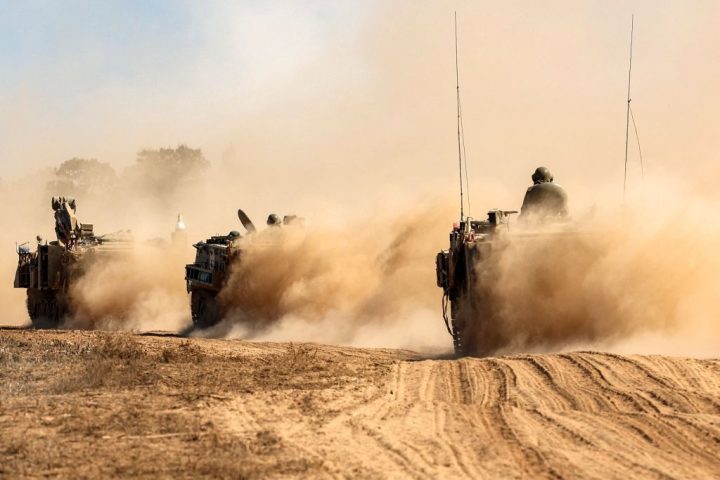In a sign that the Israeli Defence Forces (IDF) is planning to ramp up the war in Gaza, Israel has called for evacuation of 1.1 million Palestinian civilians from the northern area of the Gaza Strip. The UN quickly condemned Israel’s announcement, claiming that an evacuation within the 24-hour timeframe given is ‘impossible’, and have called on Israel to rescind its order.
The war, which started on Saturday following a surprise attack by Hamas, saw the biggest single massacre of Jews since the Holocaust. The horrific details of what ensued included the murder of babies, the rape and murder of women and girls, and people being burned alive. Civilians, including children and babies, have been abducted into Gaza.
Holding territory and controlling it is the best way to for Israeli forces reach Hamas’s leaders
In the seven days since the war started, Israel has operated in several avenues. The first, is a massive bombardment of Gaza. The aerial bombardment has targeted Hamas terrorists, essential infrastructure, tunnels and underground weapons storage facilities. It has caused large scale destruction.
Because Hamas has embedded itself deep within civilian population, including by digging underground hiding spaces for terrorists directly underneath apartment blocks, casualties have so far amounted to over 1,500, according to Palestinian sources. Many are civilians. Hamas has threatened to execute hostages if the strikes continue – a threat which has so far failed to deter Israel.
In an effort to place more pressure on Hamas, Israel has placed Gaza under siege. It cut off supply of electricity, petrol and water on Monday. Humanitarian aide is still possible, and the United Nations Relief and Rehabilitation Administration (UNRA) still operates in Gaza, but have relocated to the southern part of the strip. Food is in limited supply, and so is drinking water, much of which has become contaminated.
However, bombardment and a siege have limitations and cannot fully fulfil Israel’s aims. These include landing a decisive strike on Hamas and its leaders from which it will not recover, reaching Israeli hostages and re-establishing deterrence against Israel’s enemies, primarily Iran and Hezbollah. Israel has amassed a force of 300,00 soldiers ready to enter Gaza. A ground operation is the only way to advance these goals, but it is extremely complicated and risky warfare.
As part of its attack plan, Hamas has prepared itself for the option that Israel will send ground forces into Gaza. It has strategically placed bombs and other obstacles meant to slow down IDF forces and maximise casualties. Hamas’s tunnels can be used for offensives against Israeli soldiers, in much the same way that the Viet Cong successfully attacked (and defeated) American troops in the Vietnam war using the infamous Củ Chi tunnels.
Fighting in Gaza’s densely populated and extremely hostile environment has always been tricky for the IDF. Israel’s weariness of casualties among its soldiers has played a part in decisions about the use of ground forces for decades. In the second Lebanon war, fought in July and August 2006, for example, there was an over-reliance on airpower in order to avoid casualties. This greatly restricted Israel’s achievements. In Operation Cast Lead in Gaza (December 2008 to January 2009) and Operation Strong Cliff (2014), also in Gaza, ground forces were deployed for a short time period and did not go deep into the territory, staying on the outskirts. These decision were guided more by wanting to minimise casualties than by operative considerations.
Israel’s latest announcement to evacuate northern Gaza suggests that a ground operation may be imminent. It is not a decision taken lightly and it holds considerable risk. However, if successful, it will be strategically significant. Hamas’s leadership, the ones still in Gaza, are hidden deep within the territory, surrounded by civilians, and possibly, also by Israeli hostages. Holding territory and controlling it is the best way to for Israeli forces to reach Hamas’s leaders.
If Israeli hostages are rescued by military means, which is unlikely, it will only be done using ground forces. There are about 150 Israelis held in Gaza, according to estimates, and Israel suspects that many of them have already died. It is more likely that hostages will be released as past of a deal.
So far, Hamas is not deterred by the humanitarian crisis in Gaza, nor by civilian casualties. It has urged Palestinians not to leave Northern Gaza. Hamas has called Israel’s warning ‘propaganda’ and ‘psychological warfare’. If Palestinians stay, this will inevitably result in mass casualties. This serves Hamas in two ways. First, they can keep using civilians as a human shield. Second, it can turn international public opinion against Israel and place pressure on them to end the war.
If Israel commences a ground operation, it may be lengthy and costly. The old paradigm adopted by previous Israeli governments, and favoured by Benjamin Netanyahu in particular, was to accept Hamas’s rule in Gaza, as along as relative calm was maintained. This is no longer the case. After the horrific massacre, Israel cannot allow Hamas to exist. Destroying its considerable capabilities is a monumental but essential task that will require resilience and patience from the Israeli public, especially as military casualties are expected to mount as a result of a ground operation.






Comments